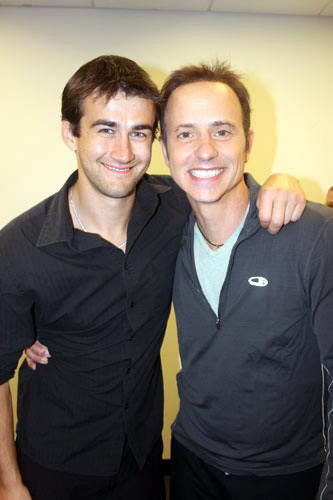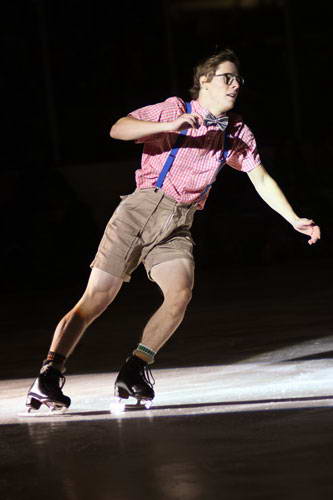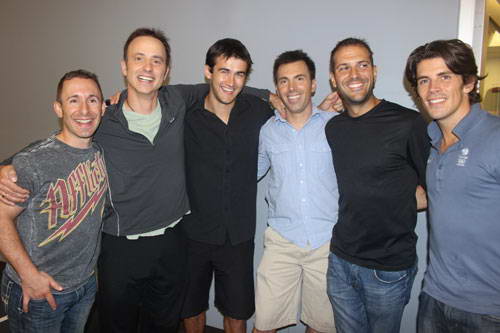|
|
ADVENTURES OF A SKATING TREKKIE
MICHAEL WEISS FOUNDATION ICE CHAMPIONS LIVE! SHOW
Story by
Dorothy Knoell
Photos by Shirley McLaughlin

For the eighth
straight year, the Michael
Weiss Foundation Ice Champions Live! show brought together the
past, present and future of figure skating in the U.S., with a goal
of helping the sport that is, those who participate in it, have
the chance to maximize their talent and become the
best they can be.
“I still
remember what a struggle my family had when my sister and I were
skating, said host and Foundation founder,”
Michael Weiss. “It costs
so much to skate and train. And this is a chance for me to give back
to all those who helped me when I was coming up.”
This was my
fourth trip to the show, and, as usual, one of my favorite skating
trips, as I not only get to see great skating, but I get to see a
real variety of skaters and skating styles and I know it’s for a
great cause, and one you see results from immediately. The
Michael Weiss Foundation
offers scholarships of differing amounts, according to need, to
up-and-coming skaters, and often times, you see past and present
scholarship recipients in the show. As their accomplishments are
announced, you actually get a chance to see your contributions at
work.
Skaters, many
of them scholarship recipients who come back now to “give back” to
the Foundation, and others who simply want to help young skaters as
they try to navigate the expensive path to skating success perform
for free, Weiss and his family provide free housing (at
their house) and local sponsors provide lots of other
necessities, while volunteers serve as set-up
and take-down staff, ushers, program sellers, etc.
The show isn’t
the only way the Michael Weiss Foundation raises funds, although Ice
Champions Live! is the major fund raiser of the year. In addition to
the show, those wishing to help can donate money or be a sponsor,
but fans also get a chance to participate in a silent auction at
the show venue (the past
several years, the Kettler
Capitals Iceplex). The auction in another way for people to
donate in a couple of ways you can donate something for the
auction (one of my friends
donated some beautiful homemade skating cards, another has offered
an original art piece) or you can bid on the items that have
been donated.
Browsing through
the silent auction before the show makes for a fun few minutes or
hour, depending on how long you want to browse. There are skating
items (autographed pictures,
figurines, jackets, tote bags, etc.) along with a lot of
non-skating items, as well. I put a bid in on a really awesome
gardening basket, full of really neat things. Unfortunately, I was
out-bid (although how I¹d have
managed to get the stuff home is beyond me, it was cute enough for
me to figure I’d worry about that later when I bid!), but one of
my friends won her bid on a really beautiful eagle figurine.
Of course, the
show is the centerpiece of the activities of the day, and this
year¹s show was, again, a wonderful afternoon of entertainment, in a
little different vein that a usual skating show. In the Weiss
Foundation show, you have a chance to really see the past, present
and future of skating, and watch skaters and skating mature and
grow. This year, there was a chance to see three or four different
levels of ladies skating, as the show opened with 13-year-old
Elisa Romola, the 2011 South Atlantic Juvenile champion and 2012
Junior National finalist, skating to
Good Time. The
spunky local girl, who noted how “amazing” it was to be in a show
with so many past and present champions (“ It inspires you to want
to skate even better.”), showed off several nice Axels and double
jumps.

Later in the
show, we had examples of what Romola might look like with a few
years of practice and seasoning behind her, as Weiss Foundation
scholarship recipients and past/present, U.S. champions
Mirai Nagasu and
Ashley Wagner.
Nagasu was a
scholarship winner very early in the program’s history, at a time
she really needed the help. Since that time, she’s been a U.S.
champion and U.S. Olympian, and after some injury problems over the
past few years, is aiming to regain the top spot. Her beautiful
performance to Crazy Dreams
showed off maturity and
beautiful interpretive skills, along with a nice triple toe. What a
difference from her first couple of performances in this show, as a
very young girl (like Romola),
still just dreaming of achieving big things as she flew
enthusiastically around the ice, all arms and legs and potential.
Those who have attended this show regularly have literally watched
her grow from the possible future of skating into a skater who is a
big part of skating present.
Then there¹s
Wagner, who won her first national title last January and appeared
to be absolutely at the top of her game heading into the 2012-13
season. She debuted her new short program to
Red Violin, and was
riveting with a triple flip, a double Axel into split jump, and
loop. She is
definitely a strong present (and
probably several years into the future) hope for U.S. ladies
skating. And seeing her mature, powerful skating a few minute after
watching the tiny but determined Romola was a wonderful moment, as
it reminded the audience that Wagner wasn’t far removed from that
time in her career, but oh, what big steps she had made - in part,
thanks to
monetary help from the Foundation and others, and in part thanks to
the former champions who left such a great legacy for her to aspire
to, and in part to her own perseverance and hard work.
And for another
side of ladies skating, there was former World champion
Kimmie Meissner, returning to the ice after some severe injury
problems since her 2006 world title. While her jumps were limited to
a couple of double Axels and a double toe loop, she was graceful and
elegant and showed how beautiful technique and connecting with an
audience can keep a career going and help keep the public interested
in skating. Meissner’s performance was one of the crowd’s favorites,
especially when she relaxed and joked with the audience as there
were delays in getting her music cued up and going.
The same kind of
‘past-present-future’ of skating was on display in dance, as well.
Local youngsters, Gigi
and Luca Becker, intermediate dance champs and also scholarship
recipients, showed of very nice skills and musical interpretation in
their performance. The 9- and 11-year-old sister-brother team has a
ton of potential. It was fun to see them at this very young
Age and makes
you want to follow their progress the next few years, when they may
progress to the level of, say,
Rachel (15) and
Michael Parsons (17), the
U.S. junior pewter medalists and Junior World Championship
participants for 2012. This young couple showed a bit more polish,
power and moves than their younger counterparts, as would be
expected, and were at a different level in development. They showed
off their Justin
Timberlake/Madonna/hip-hop Short Dance, and were very
entertaining and had some very nice lifts and twizzles.

These two forays
into the present and future of skating were accompanied by a
demonstration of the present/past of ice dance, as long-time British
champions and world championship participants
Sinead and John Kerr were also on
the program. As it turned out, Sinead, according to John, had some
visa problems and was unable to make it to the show, so John, like
the true professional he is (he and
Sinead left the ISU competitive arm of skating a few years ago),
performed on his own to Ain¹t That a Kick in the Head. (A
rather apropos song, as it turned out!). At times, he “held” his
absent partner and was obviously doing his part of a duo act, at
other times, like his single Axel jump that brought cheers from the
crowd, he was performing
entirely on his own, but whatever he was doing, he was smooth,
powerful, fast, and completely in control of his program and the
audience, which responded enthusiastically to everything he did. His
solo ice dance performance under challenging circumstances is
certainly something to inspire two young dance teams as they face the
competitive road ahead.
Kerr was
smiling, and a bit breathless, after the show, noting that he had a
great time dancing on his own, but admitting he had cut the music
somewhat to shorten the program and that skating alone left him
gasping by the end of the program, because he had to work much
harder to do all those moves on his own.
“It’s a bit hard
to keep going after a while,” he said with a laugh. “It was fun, but
I definitely enjoy skating with Sinead more.”
There were also
demonstrations of a couple of non-traditional (if you consider ‘traditional’ to be the ISU competitive track of
singles, pairs, dance) skating offered in the show, as the
Next Ice Age ice theater
group and the Capitol Steps
synchronized skating. Both were well received and provided entertaining
programs, the Next Ice Age skaters/dancers with 13 skaters, a
different number than the usual 12 or 16 were flowing and
beautiful through the early part of the program, then a bit more
upbeat later. And the Capitol Steps, with its 16 skaters, formed
intricate patterns and smiled beautifully and got a huge response
from the audience.

Then, the men
again, a wonderful mixture of up-and-coming and those who have
achieved in different ways and on different levels, and are at
different points in their careers.
Richard Dornbush, a
scholarship recipient, provided the ‘skating present/future’ moment,
as the 2011 U.S. silver medalist showed off big jumps and a series
of three double Axels in his ‘nerd’ exhibition program, but noted he
was working hard in order to challenge for the national
championships later on.
The remaining
men on the program are not aiming for medals any more in their
careers, but are examples of different ways to find success on the
ice after competition - certainly skaters Dornbush can look up to an
try to emulate on the way to success on the competitive stage, and
beyond.
Ryan Bradley
is trading on his surprise 2011 U.S. national championship, his
engaging personality and a dedication to retaining his skill level
to fulfill a dream of being an in-demand performer in shows and
tours (Stars on Ice, for one). His life has been a whirlwind since that
national title, and he¹s enjoying every minute of it. His
high-energy performance to
Footloose (a
perfect choice for him) was one of the crowd¹s favorites, and
also showed that he was not far removed from competition, as he had
a couple of big triples and was upset with himself for doubling an
intended triple Axel.
Dan Hollander
never won a national title, although he was bronze medalist twice,
and never medaled at a world championship, but has put together a
wonderful performance career by finding a specific niche that fits
him like a glove comedy skating, something he always wanted to do.
Hollander offered one of his signature comedy programs, this one
with him, starting
out as a janitor mopping up and ending with him with a clever
Popeye costume. And as
has been his custom, too, the program still included good technical
elements (how he manages a
double Axel in his way-out costumes is a mystery, and he doubled an
intended triple Salchow) and a lot of personality.
“Can¹t believe I
blew that Salchow,” he moaned after the show, demonstrating how much
these long-time pros still care about the technical content of their
programs, in addition to making sure they entertain a crowd. “But it
was fun out there.”
Steven Cousins,
an eight-time British national champion, has also carved out a great
performance career without winning world or Olympic medals. And
although he¹s gradually moving from performance to choreography (he’s the event manager for the
Disson shows this season), he is still happy to skate in an
event like Weiss’ benefit show, and is still an audience favorite.
His emotional performance to
Let It Be Me was another of the crowd¹s favorites.
And then there
is Brian Boitano, 24
years removed from his 1988 Olympic gold medal, yet still skating at
such a high level that audiences tend to not grasp really how long
it’s been since he was Olympic champion. Nearing his 49th birthday,
Boitano was still the epitome of speed, elegance and power in one of
his signature pieces from much earlier in his career,
Nessun Dorma.
A huge death
drop and glorious spread eagle were just two highlights of a program
the audience went wild for. Certainly, it was a nice moment to watch
Dornbush at a “striving for the top” moment in his career, then
watch, just a few minutes later, someone who is such a good example
of getting to the top, staying there and making a great career out
never settling for anything
less than the best he can be whenever he¹s on the ice.
To round out the
show was host and three-time national champion and two-time world
bronze medalist Weiss, who recently announced that after years of
touring (Stars on Ice) and performing in many shows and competitions, he
would leave the performing arena and move on to other things (he’s hosting several of Disson’s skating shows this year). However,
he couldn¹t resist
skating in his own Foundation¹s show, especially when he had the
chance to skate to a song sung live by his almost 14-year-old
daughter, Annie Mae.
Although Weiss
may not be training much anymore, he was still up to a triple toe
and a backflip, as Annie Mae sang
Don’t You Remember. It was
a touching moment and a fine finale for the show. After carrying his
daughter from the platform in the middle of the ice back to the
boards, Weiss returned to the ice for a few of his signature moves,
including the “Freedom Blades Spread Eagle” and his backflip, before
leading the cast out for a fun-filled finale, that included a ‘Tano
Lutz from Dornbush (why not
pay tribute to an icon when he’s right there to see it and, yes,
cheer you on?), and simultaneous backflips from Weiss, Hollander
and Bradley, which brought
cheers from the
crowd, and some cute byplay from some of the Capitol Steps skaters
as they stood arm-in-arm with Boitano during the finale (some
“wow, can you believe I’m standing arm-in-arm with him, and he’s
joking and goofing off with me?!?!!?” looks).
Boitano and
Wagner also had a good time in the bow line, relaxing and goofing
off with each other. The young skaters mixed freely with the
veterans, at times obviously getting pointers, at
other times just joking and laughing and getting a chance to feel
like a part of the whole skating world, rather than just one person
alone day after day in a rink, striking to be their best.
After the show,
the skaters, both youngsters and veterans, gold medalists and medal
hopefuls, talked mixed and mingled and talked with fans at the
post-show reception, and those waiting hopefully outside the
reception. Romola was one of several of the younger skaters eagerly
getting autographs from the rest of the cast, and the veterans were
all alike in treating everyone like family.
That¹s one of
the things that makes this event such fun to attend – the mixing of
skating generations, the chance to see youngsters learning from past
champions and veteran skaters rejuvenated by performing and mixing
with youngsters who are full of enthusiasm and hope as they face
those challenges the veterans know all about. Seeing youngsters and
veterans in the same show is also a treat, as is knowing that, while
you’re getting entertained by great skating,
you’re also helping some youngsters have a better chance to reach
their dreams.
Kudos to Michael
Weiss and his family, the many volunteers, and the wonderful skaters
who, every year, make this event something special, and to those who
attended and/or participated in the silent auction, know that you
helped the Foundation raise more than $75,000 for scholarships.

Michael Weiss and Friends
|